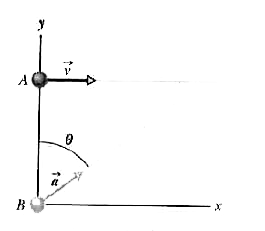A particle leaves the origin with an initial velocity →v=3ˆi m/s and a constant acceleration →a=(−ˆi−0.5ˆj)m/s2 in free space. Its velocity →v and position vector →r when it reaches its maximum x-coordinate are
→v=−2→j
→v=1.5→j
→r=(4.5→i−2.25→j)
→r=(3ˆi−2ˆj)
Step by step video & image solution for A particle leaves the origin with an initial velocity vecv=3hati m/s and a constant acceleration veca=(-hati-0.5hatj) m//s^(2) in free space. Its velocity vecv and position vector vecr when it reaches its maximum x-coordinate are by Physics experts to help you in doubts & scoring excellent marks in Class 12 exams.
Updated on:21/07/2023Topper's Solved these Questions
- TEST PAPERSBOOK - BANSALCHAPTER - TEST PAPERSEXERCISE - PHYSICS PART (A)
32 Videos
- TEST PAPERSBOOK - BANSALCHAPTER - TEST PAPERSEXERCISE - PHYSICS PART (B)
3 Videos
- TEST PAPERSBOOK - BANSALCHAPTER - TEST PAPERSEXERCISE - PHYSICS PART- C
4 Videos
- SEMICONDUCTORSBOOK - BANSALCHAPTER - SEMICONDUCTORSEXERCISE - CBSE Question
32 Videos
Similar Questions
A particle leaves the origin with an initial velodty v=(3.00ˆi)m/s and a constant acceleration a=(−1.00ˆi−0.500ˆj)m/s2. When the particle reaches its maximum x coordinate, what are
(a) its velocity and (b) its position vector?
View SolutionFrom the origin, a particle starts at t = 0 s with a velocity →v=7.0ˆim/s and moves in the xy plane with a constant acceleration of →a=(−9.0ˆi+3.0ˆj)m/s2. At the time the particle reaches the maximum x coordinate, what is its (a) velocity and (b) position vector?
View Solution
Knowledge Check
A particle has an initial velocity (6ˆi+8ˆj)ms−1 and an acceleration of (0.8ˆi+0.6ˆj)ms−2. Its speed after 10s is
A20ms−1B7√2ms−1C10ms−1D14√2ms−1A particle has an initial velocity 3ˆi+4ˆj and an accleration of 0.4ˆi+0.3ˆj. Its speed after 10s is
A10 unitB7 unitsC7√2 unitsD8.5 unitsA particle has an initial velocity of 3ˆi+4ˆj and on acceleration of 0.4ˆj+0.3ˆj . The magnitude of its velocity after 10 s is
A7√2 unitsB7 unitsC8.5 unitsD10 units .
A particle P is at the origin starts with velocity u=(2ˆi−4ˆj)m/s with constant acceleration (3ˆi+5ˆj)m/s2. After travelling for 2s its distance from the origin is
View SolutionA particle has an initial velocity 3ˆi+4ˆj and an accleration of 0.4ˆi+0.3ˆj. Its speed after 10s is
View SolutionA particle is given an initial velocity of →u=(3ˆi+4ˆj)m/s. Acceleration of the particle is →a=(3t2+2tˆj)m/s2. Find the velocity of particle at t=2s.
View SolutionIn Fig. 4-28, particle A moves along the line y = 30 m with a constant velocity →v of magnitude 3.0m/s and parallel to the x axis. At the instant particle A passes the y axis, particle B leaves the origin with a zero initial speed and a constant acceleration →a of magnitude 0.40m/s2. What angle θ between →a and the positive direction of the y axis would result in a collision?

View SolutionA body starts with a velocity (2ˆi+3ˆj+11ˆk)m/s and moves with an acceleration (5ˆi+5ˆj−5ˆk)m/s2. What is its velocity after 0.2sec?
View Solution
